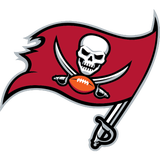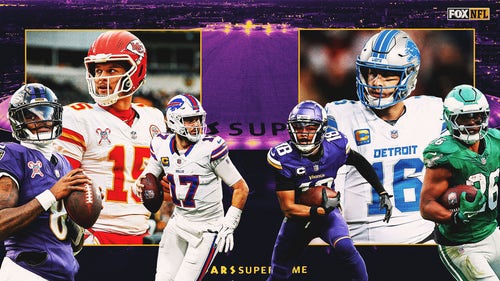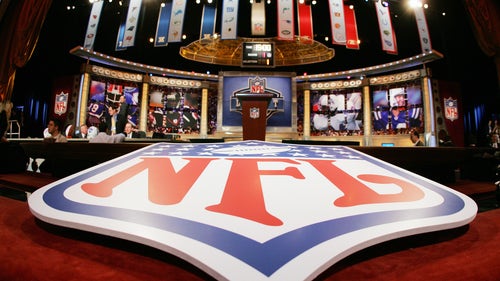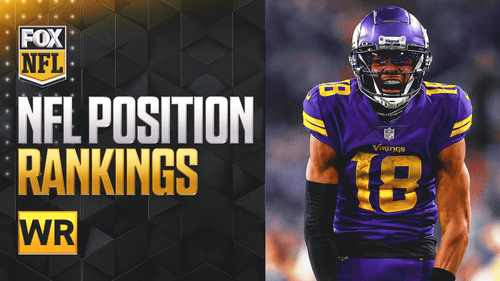
39 flags for 310 penalty yards: Revisiting the most penalized game in modern NFL history
Whether they never even knew, or have just simply tried to forget, the players who played in the most penalized game in modern NFL history are incredulous when told of their ignominious standing. Sure, they remember that the game was bad because, well, pretty much every one of their games that season was. But that bad?
“I knew there were a lot of flags, but I didn’t know we set a record,” says Seahawks receiver Steve Largent. “It doesn’t surprise me, though. Whenever we ran the ball, or threw the ball, there was a penalty on somebody, for something.”
It was 40 years ago that the Seattle Seahawks and the Tampa Bay Buccaneers entered the NFL together. Back in that era, expansion teams were forced to construct their rosters with only veteran cast-offs and through the then-17-round rookie draft; free agency wouldn’t be introduced for another 26 years, so there was no chance for either to build a competitive team. The two woebegone franchises faced off in Week 6 of their inaugural seasons, and the result was, by some metrics, quite possibly the worst NFL game ever played—the league branded it the “Expansion Bowl.”
“The NFL, as much as they could, wanted to make that game a rivalry because we were the two new teams,” says Jim Zorn, the Seahawks quarterback that game. “Over the years, it never really panned out. We were in different conferences, different divisions, and we couldn't have been any further away from each other in the United States.”
“[But] for those first two years, it was a rivalry,” Bucs receiver Morris Owens says. “I remember watching the box scores after each game to see what Seattle did, to see if they won a game.”
“John McKay, the coach of Tampa Bay, was also my coach at Oregon,” Seahawks coach Jack Patera says. “So I felt like it was more of a contest between John and myself than between Seattle and Tampa Bay. That was personal.”

When the teams met on Oct. 17, 1976 at the so-called Big Sombrero in Tampa, they had matching 0–5 records. But whereas Seattle had been at least somewhat competitive in their first five games— coming within a touchdown twice—Tampa Bay’s season was already shaping up to be an historically futile campaign (though they likely didn't know that decades later they’d be making documentaries about it). The Bucs entered the game averaging 5.2 points over their first five contests, shut out thrice, yet to even record a passing touchdown.
As a result, both teams had the Week 6 matchup circled on their calendars. It was one of the only games they were looking forward to playing in that year, because one team had to come away with their first win. And each figured they had a chance.
“We knew we may not win a game all season,” Seahawks receiver Steve Raible says, “so we had to win this one.”
“In most games we were out-manned, we just didn't have the players to compete,” Bucs running back Louis Carter says. “But we actually thought we were going to beat Seattle.”

Maybe it was because the teams were both desperate for a win, or maybe it was just one of those days, but there were 39 penalties called in the game—35 of them accepted, two off-setting and two declined—for a total of 310 penalty yards. There were 16 holding penalties. Twice the Bucs were called for having 12 men on the field, and on seven occasions they were faced with second or third down and 20 or more yards to go. McKay was even penalized once himself, for vehemently arguing a call on the field. The New York Times called the game both a “comedy of errors” and “everything it was supposed to be.”
“Maybe they were just in a flag throwing mood that day,” says Steve Spurrier, who was traded from San Francisco to Tampa Bay to be the Bucs’ quarterback that 1976 season.
“It was kind of like parents disciplining their kids, they just keep sending them to their room until they learn,” Zorn says. “That was maybe what the officials were doing—saying let’s really call this game so these two teams understand that this is the NFL. Or maybe we were just that bad.”
“I think everyone has tried to forget about it,” Patera says. “It’s not something you’d like to be in the record books for.”

One thing that most players remember about that October game was that it was uncomfortably hot—temperatures hovered at about 85 degrees, with humidity approaching 100%. “It was like a steam bath down there,” Raible says.
Raible also remembers Wayne Cody, the sideline reporter for the Seahawks radio network, sitting on the edge of the team’s bench before the game began, his chin slowly dipping down towards his chest as he gradually fell asleep, until he eventually flipped over, falling off the bench and onto his side. It was a perfect metaphor for the game yet to be played.
“There were a lot of fans who probably fell off the end of their seats at the Old Sombrero on that hot, humid day watching that awful football game,” Raible says. “It must have put a lot of those people to sleep, too, except for the flags and the way that it ended.”
The Seahawks scored the first touchdown of the game in the second quarter. The eight-play, 86-yard drive was kept alive with some trickery, when Patera called for a fake on fourth down and the team’s punter, Rick Engles, sauntered 13 yards downfield.
“The one thing we knew every game,” says running back Sherman Smith, now the Seahawks RBs coach, “was that Jack was always going to have a fake in there somewhere.”
“That season you had to consider almost anything,” Patera says. “So special teams, well, for us was special, because we didn’t have a whole lot of strength on our offense or defense.”
The drive culminated in a 15-yard touchdown pass from Zorn to receiver Sam McCullum, who remembers that his first reaction was not to celebrate, but rather to scan the field, looking for any potential flags that may have been thrown. He was surprised when he didn’t find any.

History was also made that day in the third quarter, when Tampa Bay got its first passing touchdown of the season—and in team history. But it wasn’t Spurrier who threw it. Stuck on the one-yard line, down 13–3, the Bucs attempted a dive play up the middle. Carter, whose signature move in college was leaping over the line and into the end zone, was given the ball and told to soar his way in for the touchdown.
“But before I started to even go up in the air, Seattle was already on our side of the field,” Carter says. “I was hit, and as I was falling back [to the ground] I saw Morris Owens standing there and so I threw a basketball shovel pass. I can remember the look on his face—first he was frustrated that we got stopped, then he caught it and was in total shock.”
“I was just standing there by myself,” Owens says, “and Louis bounced off the linemen, and he looked at me and then tossed me the ball. I took two steps and I was in the end zone. I wasn’t sure what happened.”
“Really? A halfback pass was our first touchdown pass?” Spurrier asks. “Man, I didn’t know that. But that makes sense. We didn't score a lot, I knew that.”

Many of the Bucs defensive players don’t remember that particular play either: “The defensive unit, when we came off—if we came off–you sat there with your head buried in your hands,” defensive end Pat Toomay says. “You didn’t watch. You couldn’t watch. You had to gather your resources and get ready to go out again into the gladiatorial arena and face your demise.”
With 40 seconds left, and Tampa Bay still trailing by three, that demise came. As kicker Dave Green lined up for a 35-yard field goal that would have sent the game into overtime, both teams were anxious. The Seahawks players had flown to Florida just one day prior—because of Patera’s inscrutable travel rules for cross-country games—and were over-heated, jet-lagged and exhausted.
“I’m on the sidelines thinking, oh god, we can’t go to overtime, we cannot keep going,” McCullum says. “It was just hope and prayers.”
Enter linebacker Mike Curtis, one of the Seahawks most respected veterans. Nicknamed “Face” because his visage was so twisted and gnarled that he looked like he slept on a bed of nails, teammates remember Curtis as the player who consumed nothing but drank eight cups of coffee before games. When Patera outlined his rules against bringing firearms to training camp, Curtis was the only guy who promptly handed over a horse pistol to the coach.
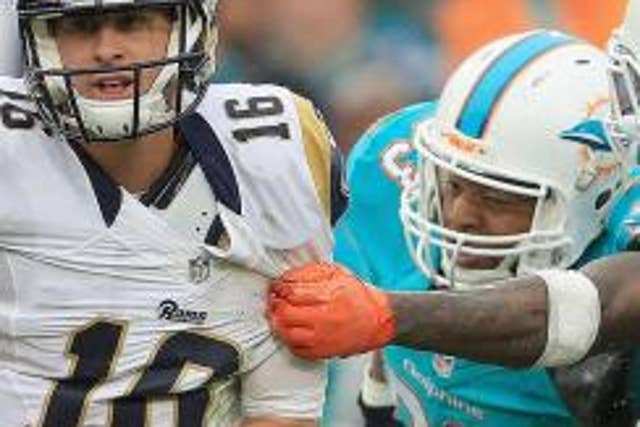
“Curtis simply said, ‘I had enough of this crap, I’ll block the kick and then let’s all go home,’” Rable remembers, “And that’s what happened. It made sense that he would be the guy to make that play and end that miserable game.”
After the blocked field goal another penalty flag was, fittingly, thrown—No. 39 on the day. This one flew high in the air, and when it came back down it hit Seattle defensive back Dave Brown, who had fallen on the ball, directly in the eye. Luckily, Brown was O.K. and the flag was on Tampa Bay, thus ending the game and everyone’s collective misery.
“I’m actually surprised more guys didn’t get hit [by flags],” Raible says. “When you throw 39 of them I’m surprised we didn’t have guys with all sorts of lacerations.”

All these years later, Owens isn’t surprised by anything that happened that day—the penalties, the fake punt, the blocked field goal: “What ever could go wrong for us,” he says, “did go wrong.”
As for the Seahawks? “Everyone was just stunned that we won,” McCullum remembers. “Everyone was just so afraid to go 0-fer. It kind of felt like we just won the Super Bowl.”
“We won two games that year, and I don't think John [McKay] won any,” Patera says, either genuinely unsure or to rub salt in an old wound. “I don’t think they won a game that year, did they?”
No, the Bucs would, of course, go on to lose all 14 games that season, and then another 12 more to start the 1977 season, as well. The Seahawks would win one more game that ’76 season, against the Falcons in Week 9, and then beat Tampa Bay again the following year. Several Seattle players take great pride in the fact that they won the first two match-ups between the expansion teams—because, even if it is no longer a rivalry, or really never was, at the time it was the closest both teams came.
“But,” as Owens points out, “we went to the playoffs before they did and we won a Super Bowl before they did.”
“Whatever makes you feel better,” Smith says. “All I know is that in ’76 we got the first win when we played them. And heck, we played them again the next season, and I don't remember losing.”
“I have never liked the Seattle Seahawks, because of those two games,” Owens says. “Those first two years, I thought we were the better team, I thought we should win both of those games. So to this day I do not like them. If no one else is, at least I am keeping [the rivalry] alive.”
Owens may be the only one. Smith says he doubts any of his current players know anything about the history between the two teams, about the “Expansion Bowl,” the penalties or even that the two franchises entered the league in the same year. And he says he doesn’t plan to educate them in the lead-up to their matchup this weekend. While the foundation for both franchises were laid in that inaugural season, Smith says, both teams are vastly different now, and so is the league. As for the possibility of seeing another game with 39 penalty flags thrown?
“Well, I sure hope that doesn't happen again,” Smith says.
This article originally appeared on
